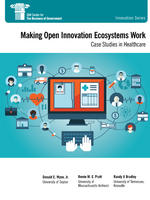
Making Open Innovation Ecosystems Work: Case Studies in Healthcare

In the mist of tightening budgets, many government agencies are being asked to deliver innovative solutions to operational and strategic problems. One way to address this dilemma is to participate in open innovation. This report addresses two key components of open innovation:
- Adopting external ideas from private firms, universities, and individuals into the agency’s innovation practices
- Pushing innovations developed internally to the public by reaching out to external channels
To illustrate how open innovation can work, the authors employ the concept of the technological ecosystem to demonstrate that fostering innovations cannot be done alone.
Successful technological ecosystems create innovation through the combination of five key elements:
- Resources – the contribution made and exchanged among the participants of an ecosystem
- Participants - the characteristics of the participants
- Relationships – the relationships and interaction among the participants
- Organization --of the ecosystem as a whole
- External environment in which the ecosystem operates
This report examines both strategies by studying two cases of government-sponsored participation in technological ecosystems in the health care industry:
- The U.S. Department of Veterans Affairs (VA) built a new ecosystem around its VistA electronic health records software in order to better facilitate the flow of innovation practices and processes between the VA and external agencies and private firms.
- The state of West Virginia selected a variant of the VistA software for deployment in its hospital system, saving a significant amount of money while introducing a number of new features and functionality for the seven medical facilities.
As a result of these studies, the authors have identified 10 best practices for agencies seeking to capitalize on open innovation. These best practices include encouraging openness and transparency, minimizing internal friction and bureaucracy, and continuously monitoring external conditions.
It is important to recognize that open source is a manifestation of open innovation in general. As such, similar issues and practices are applicable across a wide range of alternative open-innovation programs.
Listen to our podcast with the authors of this report.
Read an article about this report in Modern Healthcare.



